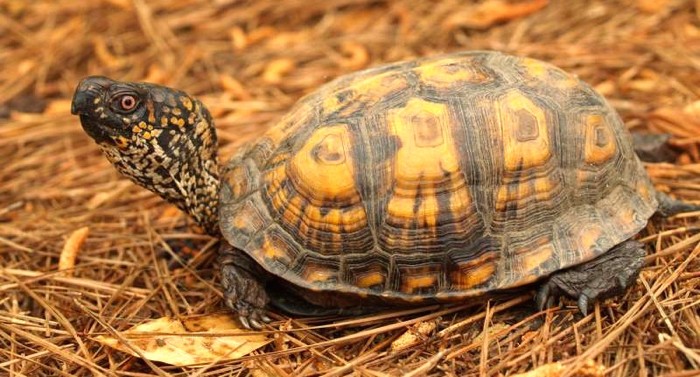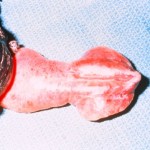Box Turtle (Genus Terrapene)
Download the Care of the Box Turtle Client Handout PDF
Natural history
Box turtles are indigenous to North America. Free-ranging box turtles spend much of their time in woodland and grassy habitats, near streams or other water sources.
Most box turtles offered for sale in the pet trade are wild-caught, and not all adapt to and thrive in captivity.
Taxonomy
Class: Reptilia
Order: Chelonia/Testudines
Family: Emydidae
There are many subspecies of box turtle in America and Asia. The eastern box turtle (Terrapene carolina), the ornate box turtle (Terrepene ornata), and the three-toed box turtle (Terrapene carolina triunguis) are the American species most commonly kept as pets.
Size
Adults range in size from 4.5-8 inches (11-20 cm) in length.
Diet
Box turtles are omnivores. Wild-caught individuals, however, may accept only meat-based foods for some time. Meat-based diets are safe for box turtles although calorie intake may have to be moderated if a pet becomes obese.
For anorectic, stressed wild-caught specimens, offer earthworms, slugs, canned cat food, strawberries and melon.
For well-acclimated healthy adults that accept vegetable-based foods:
- Approximately 60-70% of the adult diet should consist of vegetables. Greens should be mixed with other coarsely chopped vegetables such as carrots, squash, green beans, and broccoli.
- Fruits, such as apples, melons, and berries, can be offered daily.
- Juveniles require a relatively high proportion of protein. Animal protein sources can include: mealworms, kingworms, earthworms, slugs or snails, small pinky mice, and crickets.
- Provide a vitamin-mineral supplement to adults once weekly.
- Turtles are stimulated by sight and smell, so offer a varied, colorful diet.
Husbandry
| Temperature | Most box turtles thrive in ambient room temperatures. The daytime temperature gradient may range from 75-85°F (24-29°C) depending on the season, with a basking spot that reaches 85-90°F (24-32°C). The nighttime temperature should typically decrease from 65-75°F (18-24°C), depending on the season. During brumation, temperatures may be lowered to 45°F (7°C) |
| Humidity or water | Box turtles require a relative humidity of 30% to 80% although some of the rarer Terrepene species require more arid habitats. For eastern and three-toed pets, liberally mist the enclosure once or twice daily with water. Offer water for soaking and swimming. Box turtles are not good swimmers so the makeshift pool must be easy to exit and enter. A flat dish or pan can serve well. |
| Cage size | Box turtles may be kept in an enclosure with tall sides and no top. House adults in a 45-gallon (170-L) aquarium minimum, but most fare better and seem happier in wire cages or open tubs. Box turtles require a large area of dry land for basking and burrowing. Substrate should be at least 2-3 in (5-8 cm) deep. |
| Cage furniture or supplies | Provide a full-spectrum light source for optimal absorption of dietary calcium. Box turtles also require a hiding area or shelter. |
| Social structure | Box turtles may be housed in groups when provided with lots of space and visual barriers. Adults often become cantankerous during the breeding season. |
Lifespan
Box turtles are known for their longevity, with proper care they may live into their 50s or 60s.
Anatomy/ physiology
| Dermatologic: | Chelonians possess a tough, horny beak instead of teeth. The shell consists of bony plates covered with keratinized shields called scutes. The upper shell is called the carapace and the bottom shell is the plastron. |
| Respiratory: | There is a relatively short trachea with complete tracheal rings. The lungs are large and sac-like with many septa, lie against carapace |
| Urogenital: | Turtles have a thin-walled, very distensible, bilobed bladder.A single, large, smooth phallus sits on the floor of the cloaca. |
| Sexual dimorphism: | The male box turtle has a longer, thicker tail, a red iris, and a more concave plastron. |
Restraint
Box turtles are easily held by the shell or carapace, although extending the head and neck can be more challenging. Box turtles are unlikely to bite.
Due to the risk of salmonellosis, always wash your hands after handling a reptile.
Venipuncture
Dorsal coccygeal venous sinus
Jugular vein (The right vessel tends to be larger)
Brachial artery/distal humeral plexus
Subcarapacial sinus
Preventive medicine
Regular physical examination
Do not use ivermectin in chelonians
Important medical conditions
- Hypovitaminosis A
- Otitis
- Respiratory disease
- Shell trauma (free-ranging)
**Login to view references**
References
References
Bartlett PB, Griswold B, Bartlett RD. Reptiles, Amphibians, and Invertebrates: An Identification and Care Guide, 2nd ed. Hauppage, NY: Barron’s Educational Series; 2010.
Cook T. Box Turtles (Complete Herp Care). TFH Publ. 2008.
Dodds CK. North American Box Turtles: A Natural History. Univ Okla. Press. 2002.
De Vosjoli P, Klingenberg R. The Box Turtle Manual. Adv Viv Sys. 2004.
Pollock C. Basic information sheet: Box turtle. July 6, 2012. LafeberVet Web site. Available at https://lafeber.com/vet/basic-information-box-turtle/

